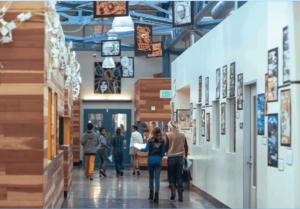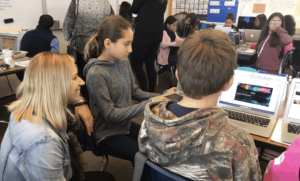Tools for Project-Based Learning: The Landscape Today

By Erik Day and Adam Kulaas
Project-based learning (PBL) has, in recent years, taken its rightful place near the top of the list of challenging pedagogies that most educators agree are worth pursuing in K-12 and post-secondary education. It sits alongside other tall orders such as Personalized Learning and Competency-Based Education as a paradigm for designing rigorous learning experiences that will better prepare students for the 21st century.
However, high quality PBL remains challenging for a noteworthy portion of educators, schools, and districts across the nation. While many teachers and schools are effectively implementing rigorous PBL, sometimes, teachers simply do not have the time and support to oversee rigorous individualized projects for 25+ students, or aren’t trained project managers, or, often, face both of these barriers. Many schools and districts do not have the budgets, staffing, standards and data to ensure fidelity of implementation at scale.
Edtech, in theory, holds great promise for expanding student access to high-quality project-based experiences–especially students in environments facing the aforementioned barriers. While quality PBL can exist without edtech, it is expensive, time-consuming, and resource-intensive. The spread of access to low-cost devices means that it doesn’t have to be that way, but tech has still yet to become a panacea for the challenges of PBL for the educators who need one most. In this post, we look at the recent history of PBL-oriented edtech, and draw some predictions about where we believe it’s headed.
A (Very) Brief Overview of Ancillary PBL Tools
Historically, a smattering of ancillary tools like Storify, Prezi, Storymaker, Padlet, MindNode Flipgrid, Buncee, Nearpod, and countless others have given students new ways to collaborate en route to their end goal and bring the end results of their projects to life. These tools can provide important student outcomes, as well: they can acclimate students to the digital nature of post-secondary life, allow them to exercise their creativity, and give them a fun way to show what they know.
But they do little to alleviate the struggles of the average teacher finding it hard to stay afloat in a project-based environment (and to be fair, they don’t purport to), and tend to have few (if any) features targeted at the system level. These tools, the end users of which are primarily students, tend to have limited and rudimentary tracking and data analysis options, and do not always readily integrate into larger-scale LMSs.
To fill this gap, tools designed to organize and facilitate certain components of PBL (which are generally a step up in terms of foundational support and organizational complexity, and are often targeted at schools rather than individual classrooms) have begun to increase in popularity.
Tools Targeted at Fundamental Components of PBL
Where does a teacher turn if they need supporting structures for an intended classroom culture focused on design thinking and “grit”? Where do they go if something just feels “off” about one of their students’ projects? How can they incorporate real-world experiences and input into learner experiences if their school has strict rules about out-of-class time?
These challenges are easy to imagine, and they illustrate the broad range of barriers facing teachers and schools in the shift to PBL. They are also questions that organizations have already begun to develop resources to answer.
We recently learned about FINAO (Failure Is Not An Option), a “social platform” designed to emulate Facebook, but with a focus on creating positive culture around setting and striving toward goals. “Our goal is to be encouraging students to be purposeful in their engagement – to create goals (big or small, short- or long- term) and post updates towards reaching (or not reaching) those goals,” says Donna Wang, Executive Vice President of FINAO. She tells us that providing this structure (with an intentional front-loading of priority-setting) for students has shown some promising initial results (the platform launched recently, and has rolled out to a few schools, with a few more in the planning stages). While FINAO is not specifically designed to be a PBL tool according to Wang, we think the idea fits naturally into this list.
Educurious provides project-based secondary courses and connects students to a proprietary “Expert Network.” They also offer PBL PD.
The Buck Institute for Education, the giant in the arena, offers a wide range of great (and mostly low-tech) resources for getting at the analytical side of what makes for a “good” project. From project planning forms that provide checklists for project plans to rubrics, to the recent Framework for High Quality PBL (which we partnered with Buck to develop), these tools can provide continued food for thought for educators questioning the depth or rigor of their students’ progress.
But yet again, while these tools are interesting and valuable solutions to big challenges (the selected tools above being only a few of a swathe of existing offerings), they do not get at the heart of the promise that edtech has for creating structures in which wide-spread PBL can thrive. They can certainly still provide a lot of value to some schools (especially those that may not be ready for, or want to pursue, a head-first dive into PBL), but they are unlikely to create new opportunities for schools or districts facing resource constraints.
System-Level Tools Changing the Game
To truly create equitable access to high quality PBL for all students regardless of socioeconomic background or geographic location, affordable platforms will be needed that can streamline project management for both teachers and students, enable timely feedback and collaboration at all levels, and, perhaps most importantly, scale interoperable data and tracking systems to entire schools and districts to ensure efficacy of implementation and broad success. Implementation of such tools would, in theory, give schools and teachers the space to focus on important components of PBL such as:
- Creating powerful cultures around concepts like design thinking,
- Providing social-emotional learning and support for all students, and
- Real-world outcomes for student projects
For the remainder of this piece, we refer to such tools as “holistic” PBL platforms.
And, while there may not be one tool that currently lives up to this (admittedly very high) standard, there are a number of players jockeying to be the first.

Edio, a platform founded by Shane Krukowski and Mike Hourahine, amplifies the dynamic lens that these two combine to deliver a user-friendly, visually pleasing, customizable platform that is fluid in enhancing and facilitating the delivery of high quality project-based learning. As one of the most exciting demos of the new year, edio has only begun to make its mark, and boasts a design approach that includes highlights, such as the application of learner empathy through transparent solutions that seamlessly eliminate common PBL implementation and scaling components with what could be described as a project-based learning “GPS.” Their guiding principles include:
- Meet learners where they are.
- Facilitate meaningful dialog for learners.
- Help inspire, motivate & connect learners with opportunities.
- Express learning to the world.
Edio bundles a package of student-controlled opportunities that fuel personalization, and progress-monitoring that visually communicates growth on an individual student level. Additionally, the collaboration components (as a necessity of #HQPBL) build bridges in a variety of group sizes that can be navigated in partnership with teaching staff. With a product goal to provide full support for student design and student-owned project creation, this platform appears set to solidify the power of student-centered learning in the world of high quality project-based learning.
Workbench is another PBL platform that is licensed “software-as-a-service” to districts with per-school pricing. Compared to DIY PBL, where teachers typically need to design the entire project, Workbench offers easy to use authoring tools and a big library of projects to adopt, adapt and integrate into a bigger project-based learning experience. The Platform is already used in over 10,000 schools around the world making the creative and collaboration power strong. (See our full feature on them).
Project Foundry, also founded by Shane Krukowski (prior to Edio), is another such platform, claiming to “streamline the workflow for personalized, deeper learning… to help guide and monitor the complex process of project-based learning.”
Schools in the New Tech Network use the Echo platform, which features a project library, authoring tools, and PBL assessment rubrics, and a competency-based gradebook.
What’s Next:
Imagining current PBL edtech offerings on a continuum ranging from ancillary to holistic (where the x-axis value is determined by system-level support of the tools) provides some interesting insights (though please note that we do not recommend using this criteria to judge overall potential “value” of a product).

As demand for tools that facilitate PBL at a large scale inevitably increases, the cost of holistic tools, at the right end of the chart, will most likely go down, while quality and features will improve (this assumes that multiple competitors stay in the arena). As more schools begin to use these holistic tools, it would seem that those in the middle of the spectrum will increasingly be pressured to integrate with holistic systems, be purchased by them, or face limited options for growth.
This suggests that high quality PBL will continue to become a more and more realistic option for districts regardless of location and budget. We are hopeful that this shift will continue to accelerate.
For more, see:
- How and Where EdTech Will Help
- Introducing a Framework for High Quality Project Based Learning
- How to Create & Cultivate a PBL Culture
Stay in-the-know with all things EdTech and innovations in learning by signing up to receive the weekly Smart Update. This post includes mentions of a Getting Smart partner. For a full list of partners, affiliate organizations and all other disclosures, please see our Partner page.







Grace Magley, Director of Digital Learning
I have been working with my district and others in Massachusetts who are trying to leverage project based learning to personalize learning for K-12 students. My colleagues and I have been teaching K-12 educators for the past several years using bie.orgs materials. This year we partnered with Kathleen Fritz from the company CREATOMbuilder Inc. Kathleen has provided us with training using her Design Thinking templates and tools to teach educators how to design PBL units and for the advanced PBL teacher how to teach students how to design their own PBLs. The results in the first year have been fantastic! I can't say enough about how this system works for anyone from novice to advanced, from Kindergarten teacher to High School Civics teacher in being able to create high quality PBL projects that are aligned to BIE's essential elements and the teachers goals for standards and skills in the first year! This summer we will be running a three day PBL coaches workshop using the CREATOMSetGo System. It is the way my district will be teaching all educators how to design PBL moving forward. For more information go to: https://www.creatomsetgo.com/
Replies
Erik Day
Thanks for the comment, Grace! Looks interesting--we'll check it out.